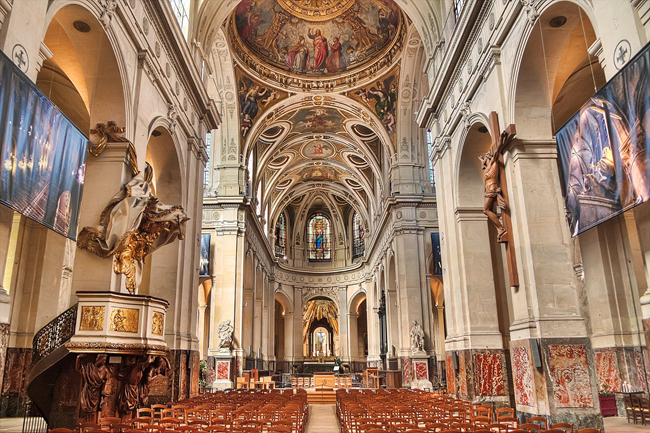The Smart Side of Paris: The ‘Patrimoine’ of Saint Roch Church
Just a block from the Tuileries Gardens on the Rue Saint Honoré, you can find the somewhat nondescript Baroque façade of the Saint-Roch church. It is, in fact, so mundane that it would be easy to walk by without feeling the temptation to peek in. Yet the church’s history alone is enough to inspire curiosity in even a hurried tourist. Louis XIV laid Saint Roch’s first stone, and Napoleon scattered royalist troops from its steps with cannon fire in 1795. And somehow the church became a magnet for atheist burials. At one time, Denis Diderot, Baron d’Holbach, Claude-Adrien Helvétius, and the Marquis de Sade were all memorialized there! Surely that should be enough!
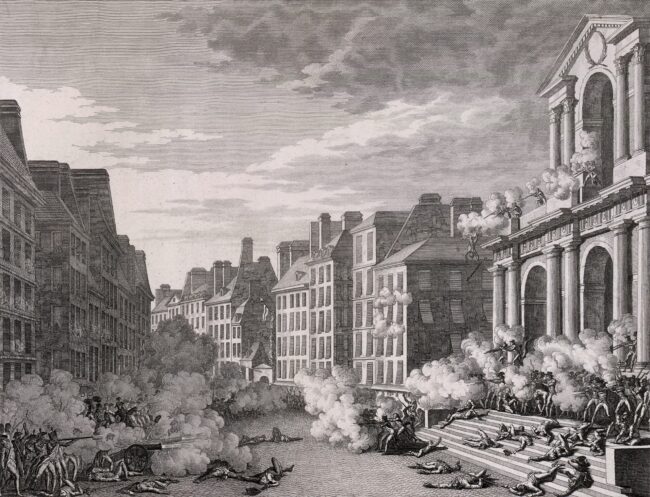
General Bonaparte had his cannon fired at the royalist insurgents. The impacts on the facade are still visible today. Engraving by Abraham Girardet (1764-1823). Public domain
The church’s construction proceeded in fits and starts for the first century of its existence and remodeling continued well into the 19th century. Testimony to this, inside, you will find extravagant and impressive architecture, paintings, and sculptures in a mélange of styles. The white stone is striking; the dome, which depicts the Assumption by Jean-Baptiste Pierre is breathtaking (binoculars help); several paintings (Saint Denis Preaching in Gaul, The Return of the Prodigal Son) are impressive; and the stained glass is quite beautiful.
Despite all this variety of beauty, the item I find most interesting inside Saint-Roch is a plaque dedicated to André le Nostre (also known as Le Nôtre), which is off to one side and barely noticeable. It reads:
“To the Glory of God. Here rests the body of André le Nostre, Knight of the Order of Saint Michael, the King’s Counsellor, Controller General of His Majesty’s Buildings, Arts and Manufacturing [Métiers] of France. He undertook the beautification of the gardens of Versailles and other royal residences. The strength and expanse of his genius made him unique in the art of gardening [i.e., the art of creating gardens] such that one can think of him as having invented the main principles of beauty and having raised them to their ultimate perfection. He was responsible for the excellence of his works to the grandeur and excellency of the monarch he served, which brought him many blessings. Not only did France benefit from his work, but all the princes of Europe desired to have his students; indeed, no one could compare to him. He was born in the year 1613 and died in the year 1700.”
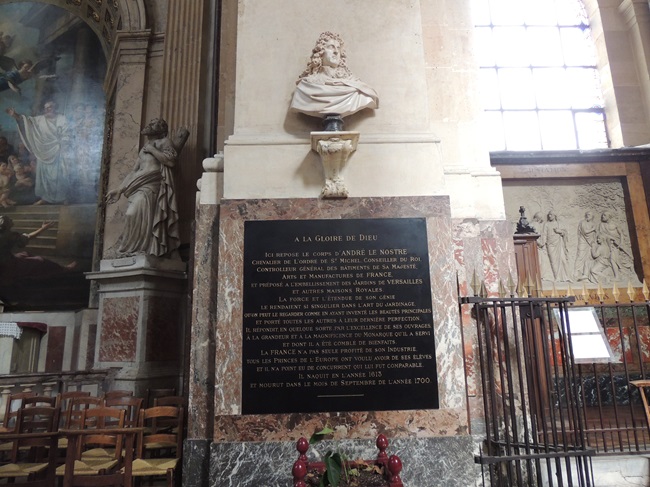
Plaque to renowned landscape architect André Le Nôtre inside Saint Roch Church. Photo credit: John Eigenauer
Several things fascinate me about this memorial. First, it is inside a church, and yet does not relate to a religious matter; Le Nostre was not considered a saint and did not serve the Church directly. Next is the subtle, grateful acknowledgement that his work was a great service to France. Pride in beautification is national, and the process of beautification extends far beyond creating beautiful things; beautification for the French is an act of consecration. The third is that what he did, what he knew, the “savoir-faire” that he passed on to his students, and the continuing existence of his work (in Versailles, Sceaux and other places) is now part of the collective patrimoine that the French feel should be preserved and of which French people are proud. One could say that he developed his métier so well that it became part of France’s patrimoine. Indeed, France celebrated the 400-year anniversary of Le Nostre’s birth with fairs, exhibitions, talks, and fireworks displays at Tuileries Gardens, the Champs Elysées, Chantilly, Sceaux, and Vaux-le-Vicomte, where his fame began.
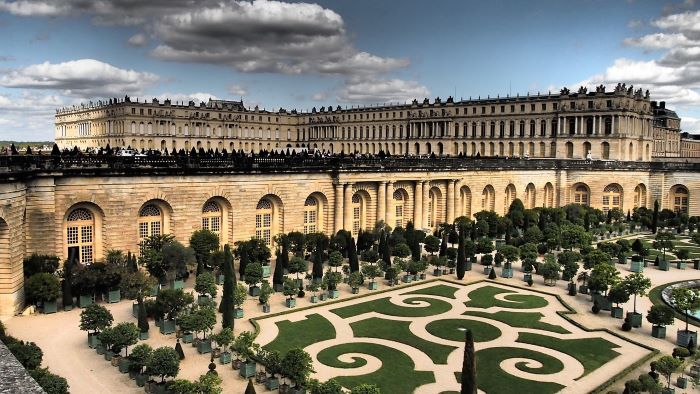
The Palace of Versailles. Photo: Andreas H./ Pixabay
Like the word métier, the word patrimoine does not translate easily to English. We say “patrimony” or “heritage,” but the words seem less familiar to English speakers. Valérie Desprets points out that the scope of the word has “evolved considerably over time” from referring to physical possessions to something that “brings together a culture and its shared history.” Indeed, “there has been a progressive shift towards a notion with emotional, symbolic and hallowed characteristics.” Patrimoine can still consist of physical objects such as a family’s material possessions or even public monuments, but for the French, it also includes “customs or knowledge reflecting the history of an individual, group, nation or humanity.”

Saint Roch stained glass. Photo credit: John Eigenauer
The American writer Sherwood Anderson captured elegantly the sense of pride that makes possible a collective understanding — a deep feeling — among the French of a mutual ownership of their cultural heritage. While living in Paris, he wrote that a friend “spoke of a sense of ownership of France in the French. It is true. It is like an immense stock company with big and little owners,” but that there is “a sense of other standards here. It is perhaps because every Frenchman feels himself as in some way having a share in France…. In the past beautiful things have been done. Even though a man is a waiter in a café under the shadow of the cathedral of Notre Dame he feels himself in some obscure way a part of the cathedral. Frenchmen built it. He is himself a Frenchman. He is a stockholder in the great company, that is France.”
All of the insides of Saint Roch are part of France, and part of the French. What at first seems a mélange of art and architecture — classical and Baroque; Doric and Corinthian columns; stark white ceilings and elaborately painted domes — is a testimony to more than its 200 years of remodeling: it is a reminder that all that is gathered under its immense roof is part of the patrimoine of France.

The altar in Saint Roch Church. Photo credit: John Eigenauer
And that is why, inside the very Catholic Saint Roch church, one also finds this beautiful memorial that unifies Christianity and Judaism with the stained glass above and a memorial of the “martyrs” (the word used in the memorial) of the Jews who died in ten Nazi camps:
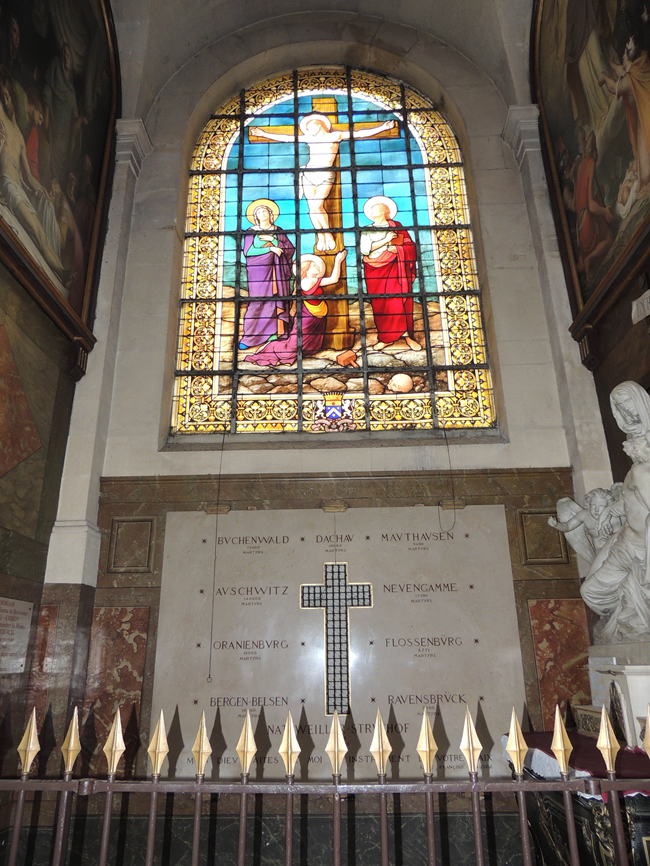
Memorial to the martyrs in Saint Roch Church. Photo credit: John Eigenauer
Louis XIV laid the first stone; sculptors and painters came and went; Napoleon fired canons at the church’s steps; Le Nostre created the art of designing beautiful gardens; the Holocaust invaded France. It all happened. It all needs to be remembered. The Assumption is immortalized in a dome; Le Nostre in a plaque; the deaths of the Holocaust in a stone sanctuary; Denis-Auguste Affre, who was killed trying to negotiate peace during the 1848 Revolution, has his own stained glass window, as does Jesus on the cross. And this summer, I watched a class of French third graders practice their dance routine to Queen’s “Don’t Stop Me Now” on the front steps of Saint Roch. Who knows but that someday that, too, will be commemorated on its hallowed walls.

“Window of Denys Affre,” Bishop martyred in 1848 Revolution. Photo credit: GO69 / Wikimedia commons
Lead photo credit : Saint-Roch church in Paris. Photo: Joe deSousa/ Wikimedia Commons
More in Paris churches, Saint Roch Church, The smart side of Paris, walking tour
